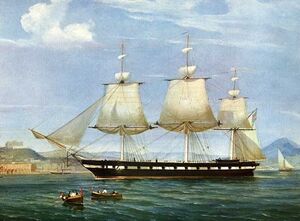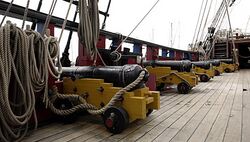CTT Txatka: Difference between revisions
mNo edit summary |
mNo edit summary |
||
| Line 33: | Line 33: | ||
|Ship struck = | |Ship struck = | ||
|Ship reinstated = | |Ship reinstated = | ||
|Ship homeport = Tyúregar, [[Cadenzan Kamalbia]] <small>(until 1814)</small> | |Ship homeport = Tyúregar, [[Cadenzan Kamalbia]] <small>(until 1814)</small> | ||
[[Port of Cadenza]] | |||
|Ship identification = | |Ship identification = | ||
|Ship motto = | |Ship motto = | ||
Latest revision as of 01:58, 31 December 2020
 Txatka at port in Kamalbia, 1811.
| |
| History | |
|---|---|
| Name: | CTT Txatka |
| Namesake: | The magpie (txatka in Khadenz), national bird of Cadenza |
| Laid down: | 3 January 1784 |
| Launched: | 15 March 1786 |
| Commissioned: | 4 April 1786 |
| Homeport: |
Tyúregar, Cadenzan Kamalbia (until 1814) Port of Cadenza |
| Status: | Museum ship |
| General characteristics | |
| Class and type: | Txatka-class 38-gun frigate |
| Displacement: | 1260 tonnes |
| Length: | 52 metres overall |
| Beam: | 12.9 metres |
| Draught: | 6 metres |
| Propulsion: | Sail |
| Complement: | 355 officers and enlisted |
| Armament: |
|
CTT Txatka (meaning magpie in Khadenz) is a 38-gun frigate of the Cadenzan Navy. It is the oldest commissioned naval vessel afloat in the Trellinese Empire, though after taking extensive damage in the Bernadottic Wars much of the hull was rebuilt to a slightly larger configuration.
Design and construction
Txatka was the first ship of the Cadenzan navy's Txatka-class of frigates, ordered with the express purpose to "dismay any foe they might encounter, and evade those who might o'ermatch them", as Cadenza was increasingly outnumbered by other naval powers in the region. The ships were designed by Maranz ti'Galet, a prominent shipbuilder from Canve, who built them with wood imported from Nikolia. The class was designed with a long and narrow hull, intended to allow the mounting of heavier guns than frigates of other navies.
Txatka's keel was laid down at a dockyard in Canve on 3 January 1784 and she was launched two years later, on 15 March 1786.
